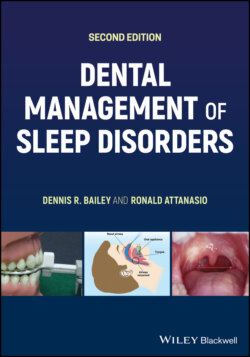Читать книгу Dental Management of Sleep Disorders - Ronald Attanasio - Страница 32
REM Sleep (Stage R)
ОглавлениеREM sleep is also referred to as dream sleep. Even though it comprises about 20–25% of the total sleep time, this state recurs several times throughout the overall cyclical activity of NREM and REM states during sleep. In normal sleep, each subsequent recurring REM period is typically longer than the prior REM period.
EEG activity is increased with a characteristic “sawtooth” waveform and may appear similar to wakefulness, hence the term paradoxical sleep. There is typically an increase in heart rate, respiration, blood pressure, and eye movements. During this state of increased cerebral activity there may be an immobility or paralysis of the muscles in the limbs, which has been thought to be a mechanism to prevent one from acting out their dreams during sleep [6].
REM sleep may also be contributory to memory consolidation [7], known as procedural and spatial memory. Procedural or declarative memory is associated with automatic retrieval of everyday tasks, facts, and events and spatial memory deals with the ability to have ongoing familiarity with the environment in which we live. Memory primarily involves an area known as the hippocampus, part of the limbic system of the brain. The limbic system, which is not a distinct structure but comprised of various other structures, also involves the hypothalamus along with the amygdala, a structure involved with memory and decision‐making. In addition, two paired structures, the mammillary bodies, also part of this system, are involved with memory [8].
REM sleep consists of two phases, tonic and phasic [9]. Typically a sleep study report will not make a distinction between these two phases. Tonic REM is a unique phase by virtue of the following characteristics:
Atonia (loss of muscle tone) of the skeletal muscles that appears near paralysis except for the diaphragm and extraocular eye muscles.
Desynchronized EEG activity with widespread neural activation or wake‐like EEG activity.
Phasic REM is unique because it may be sporadic as opposed to being continuous and has the following characteristics:
Bursts of REM (eye movements in all directions)
Transient swings in blood pressure and heart rate along with tongue movement and irregular respiration
Myoclonus (muscular jerks), twitching of the chin, and limb movements
REM sleep is typically the stage of sleep associated with dreaming although dreams do occur in NREM, primarily in Stage N2. Dreaming during REM tends to be associated with better recall, as compared to N2 sleep, and have a more defined storyline [10]. REM dreams may also be hallucinatory.
